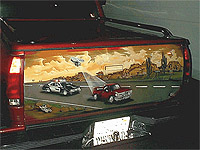|
 What
goes on in a pursuit from inside the patrol car What
goes on in a pursuit from inside the patrol car
By Jim Holcomb
We see them every day-they're the high-speed pursuits that
bring us to the edge of our seats as we watch the drama unfold.
Sometimes they drag on, but there is always the hope of a
dramatic ending. But, that's not the way the police view it.
For the officer in the black and white patrol car it's all
pre-planned.
On the initial realization that the pursuit is in progress
several things happen. First, all windows are rolled up so
the siren won't drown the pursuit broadcast out. The driver
officer concentrates on the suspect vehicle to the exclusion
of everything else. The passenger officer secures any loose
items (notebooks, ticket books, flashlights, etc) so they
won't fly around inside the patrol car and possibly interfere
with the driver. Seat belts are checked. The shotgun is unlocked,
and the passenger officer continues to advise communications
of the location, speed and the actions of the suspects. An
air unit is requested by communications and will call out
cross traffic as the pursuit approaches intersections. All
responsibility for the pursuit rests with the senior officer
in the primary black and white, unless a field supervisor
relieves him.

When the license number is obtained, communications does a
series of checks. They check for "wants and warrants" to see
if the car is stolen or if it is being sought in connection
with a felony warrant. The registered owner's name and address
will be checked in order to see if the vehicle is heading
towards, or away from, a local address. If the car is not
reported stolen, communications will try and contact the registered
owner to determine if the car may be an "unreported stolen."
All of this happens as the chase continues. Public safety
is always a first concern and is weighed against several factors:
First, the risk involved in continuing the pursuit (vs) allowing
the suspect to get away. Second, the likelihood the suspect
may cause harm to someone if not caught immediately.
Supervisors take part in the decision process by monitoring
the pursuit and also consider alternative ways to end the
chase. One technique for stooping a chase is called the Pursuit
Intervention Technique (PIT).
Optimally, it is done at 35 miles per hour (or less). When
the police car maneuvers its front quarter panel next to the
rear quarter panel of the suspect's vehicle, the police officer
turns his steering wheel one quarter turn in the direction
of the suspects vehicle-accelerates-and causes the suspects
vehicle to loose traction and spin out.
This is mostly used by the CHP, but is slowly being adopted
by other agencies. Another tool is a "spike strip." Spike
strips only work well when the path of the suspect's vehicle
can reasonably be determined, the roadway is clear of other
cars, and can be deployed far enough in advance of the pursuit.
While these and other methods of stopping a pursuit are always
being considered, none are with out potentially dangerous
"side effects." That's why they are used so sparingly!
When the pursuit finally ends, caution is paramount. But,
getting immediate control of the situation as soon as possible
(without someone getting hurt) is the ultimate goal. Overall,
the high-speed chase is the single most physically and emotionally
demanding event an officer can face during a "normal" day.
They are just as demanding for those of us who cover them
from the helicopter as well.
About the Author
JIM HOLCOMB is a Reporter-Pilot for KCOP-TV in Los Angeles.
He is a former 26-year veteran of the LAPD and has worked
in several diverse assignments, including tactical flight
operations in the Air Support Division.
|

















